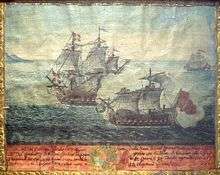Barbary Coast
The term Barbary Coast (also Barbary, Berbery or Berber Coast) was used by Europeans from the 16th century to the early 19th to refer to the coastal regions of North Africa, specifically the modern nations of Morocco, Algeria, Tunisia and Libya.

The term was coined in reference to the Greco-Roman view of barbarians as people beyond the realm of civilization. Between the 16th and 19th century North Africa was a major center for piracy and privateering. Emerging European powers thus associated a ‘barbarian’ status to the Muslim and Ottoman rulers and peoples, hence Barbary Coast.[1]
History
Barbary was not always a unified political entity. From the 16th century onwards, it was divided into the political entities of the Regency of Algiers, Tunis, and Tripolitania (Tripoli). Major rulers and petty monarchs during the times of the Barbary States' plundering parties included the Pasha or Dey of Algiers, the Bey of Tunis and the Bey of Tripoli.[2]

The first military land action overseas by the United States was executed by the US Marines and the US Navy, was the Battle of Derna, Tripoli, a coastal town now in eastern Libya, in April 1805. It formed part of an effort to destroy all Barbary pirates, to free American slaves in captivity, and end piracy acts between the warring tribes on the part of the Barbary states, which were themselves member states of the Ottoman Empire. The opening line of the Marines' Hymn refers to this action: "From the halls of Montezuma to the shores of Tripoli..." It was the first time that the US Marine Corps took part in offensive actions outside the United States.
See also
- Ottoman Algeria
- Ottoman Tripolitania
- Ottoman Tunisia
- Tunisian navy (1705-1881)
- Turkish Abductions
- Republic of Salé
- Sharifan Empire – History of human habitation in Morocco, since prehistoric times
- Langue de Barbarie
- Barbary duck
References
- Colás, Alejandro (February 2016). "Barbary Coast in the expansion of international society: Piracy, privateering, and corsairing as primary institutions". Review of International Studies. 42 (5): 840–857. doi:10.1017/S0260210516000152. ISSN 0260-2105.
- Chisholm, Hugh, ed. (1911). "Barbary Pirates" . Encyclopædia Britannica. 3 (11th ed.). Cambridge University Press. pp. 383–384.
Sources
- London, Joshua E. (2005), Victory in Tripoli: How America's War with the Barbary Pirates Established the U.S. Navy and Shaped a Nation, New Jersey: John Wiley & Sons, Inc., ISBN 0-471-44415-4
- LAFI (Nora), Une ville du Tamazgha entre ancien régime et réformes ottomanes. Genèse des institutions municipales à Tripoli de Barbarie (1795–1911), Paris: L'Harmattan, 2002, p. 305
External links
| Look up Barbary Coast in Wiktionary, the free dictionary. |
- "When Europeans Were Slaves: Research Suggests White Slavery Was Much More Common Than Previously Believed", Ohio State University
| |||||||||||||||||||||||||||||||||||||||||||||||||||||||||||||||||||||||||||||||||||||||||||||||||||||||||||||||||||||||||||||||||||||||||||||||||||||||||
Barbary Corsairs | |||||||||||||
|---|---|---|---|---|---|---|---|---|---|---|---|---|---|
| |||||||||||||
| |||||||||||||
| |||||||||||||
| |||||||||||||
| |||||||||||||
| Authority control |
|
|---|

